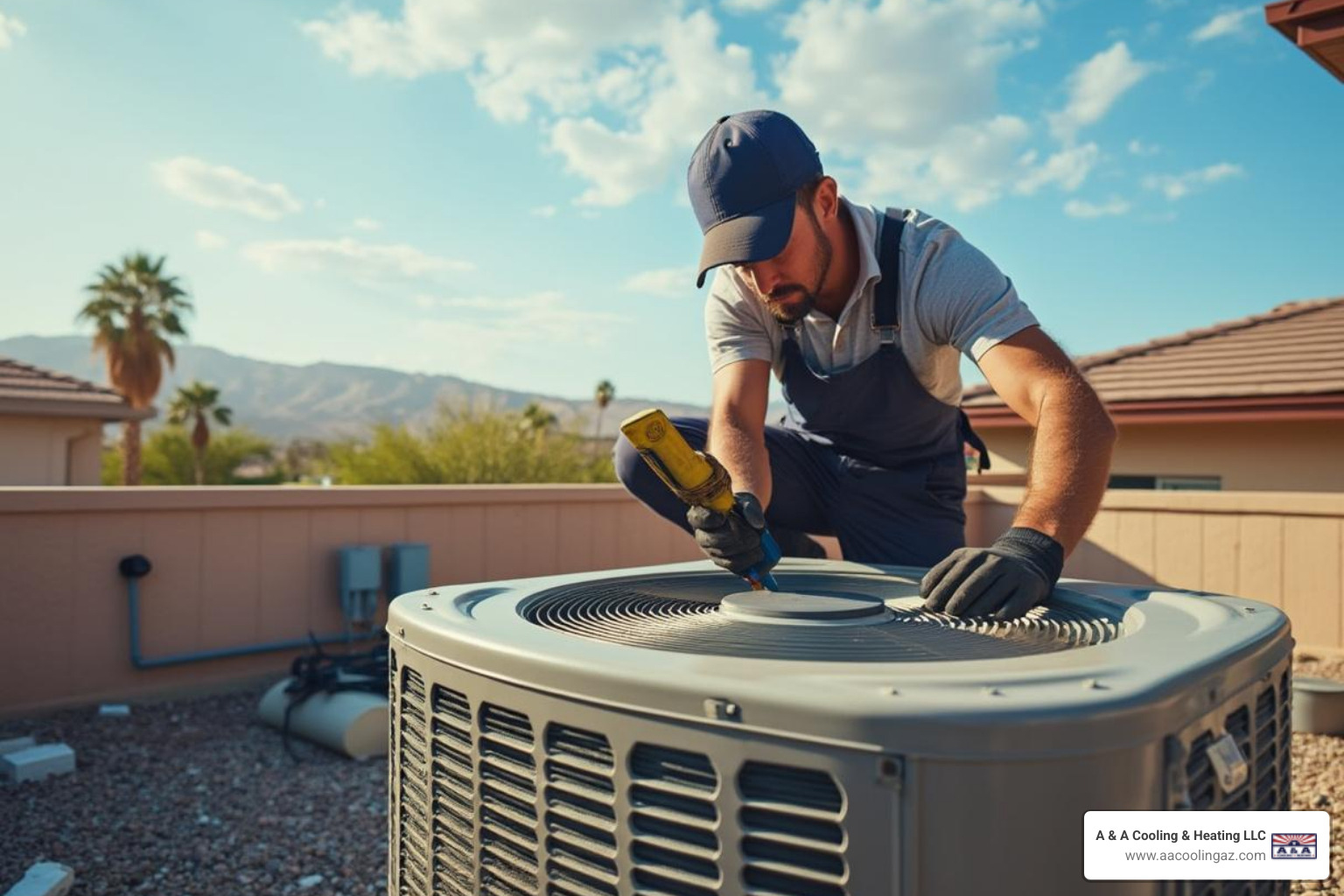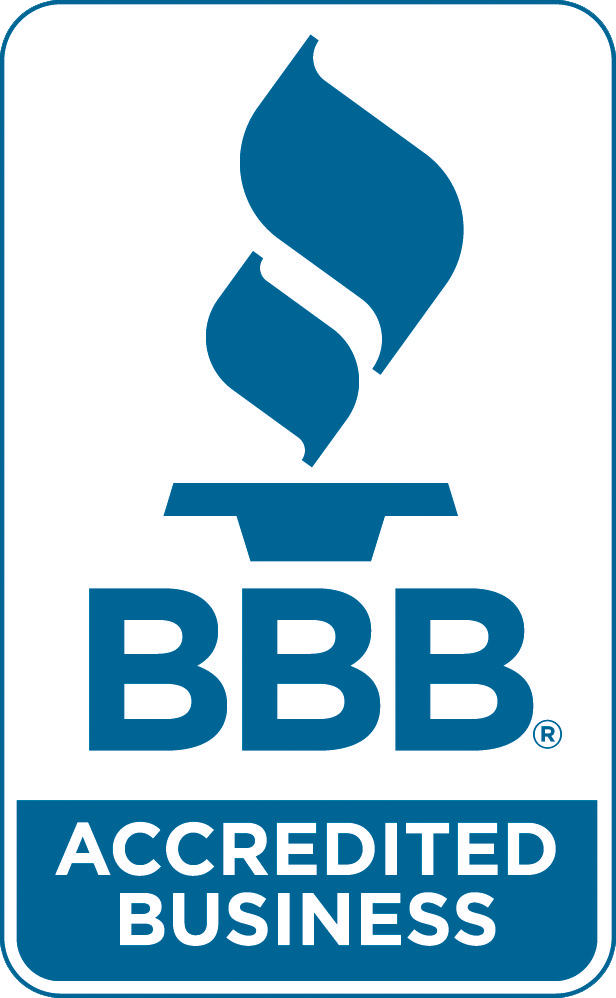The Cool Down: Demystifying AC Refrigerant for Homeowners
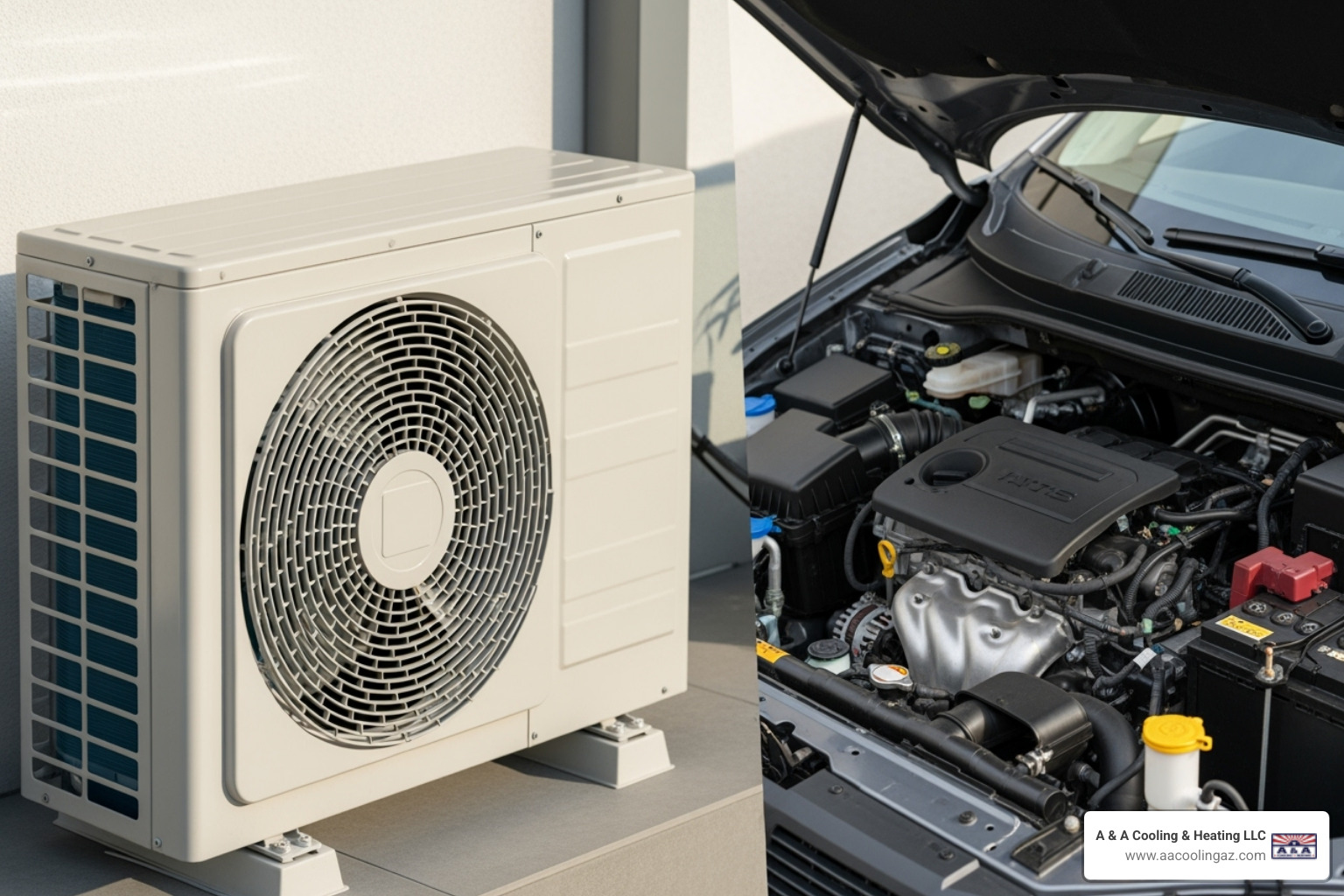
What is an AC Refrigerant Recharge?
AC refrigerant recharge is the process of adding refrigerant to your air conditioning system when levels drop too low to cool effectively.
Quick Answer for Homeowners:
- Home AC systems are sealed and should never need a recharge unless there's a leak.
- Only EPA-certified professionals can legally recharge home AC units.
- Signs you need service: warm air, ice on coils, hissing sounds, higher bills.
- Car AC systems can sometimes be recharged DIY, but home systems cannot.
Quick Answer for Car Owners:
- DIY recharge kits are available for cars.
- Average leak rate: about 0.41 ounces per year in newer cars.
- When to get help: if a recharge lasts less than a season, you have a significant leak.
Refrigerant is the chemical that makes cooling possible. It absorbs heat from inside your home or car and releases it outside in a continuous cycle. This happens in a sealed system that reuses the same refrigerant repeatedly.
The critical point is that your AC doesn't "use up" refrigerant like a car uses gas. If your system is low, it means there's a leak.
For home AC units, this always requires professional diagnosis and repair. The leak must be found and fixed, or the new refrigerant will just leak out again. Plus, handling refrigerant without proper certification is illegal and dangerous.
Car AC systems are different. They have accessible service ports, and DIY recharge kits are legal and available. However, if you're recharging more than once every year or two, you have a leak that needs professional attention.
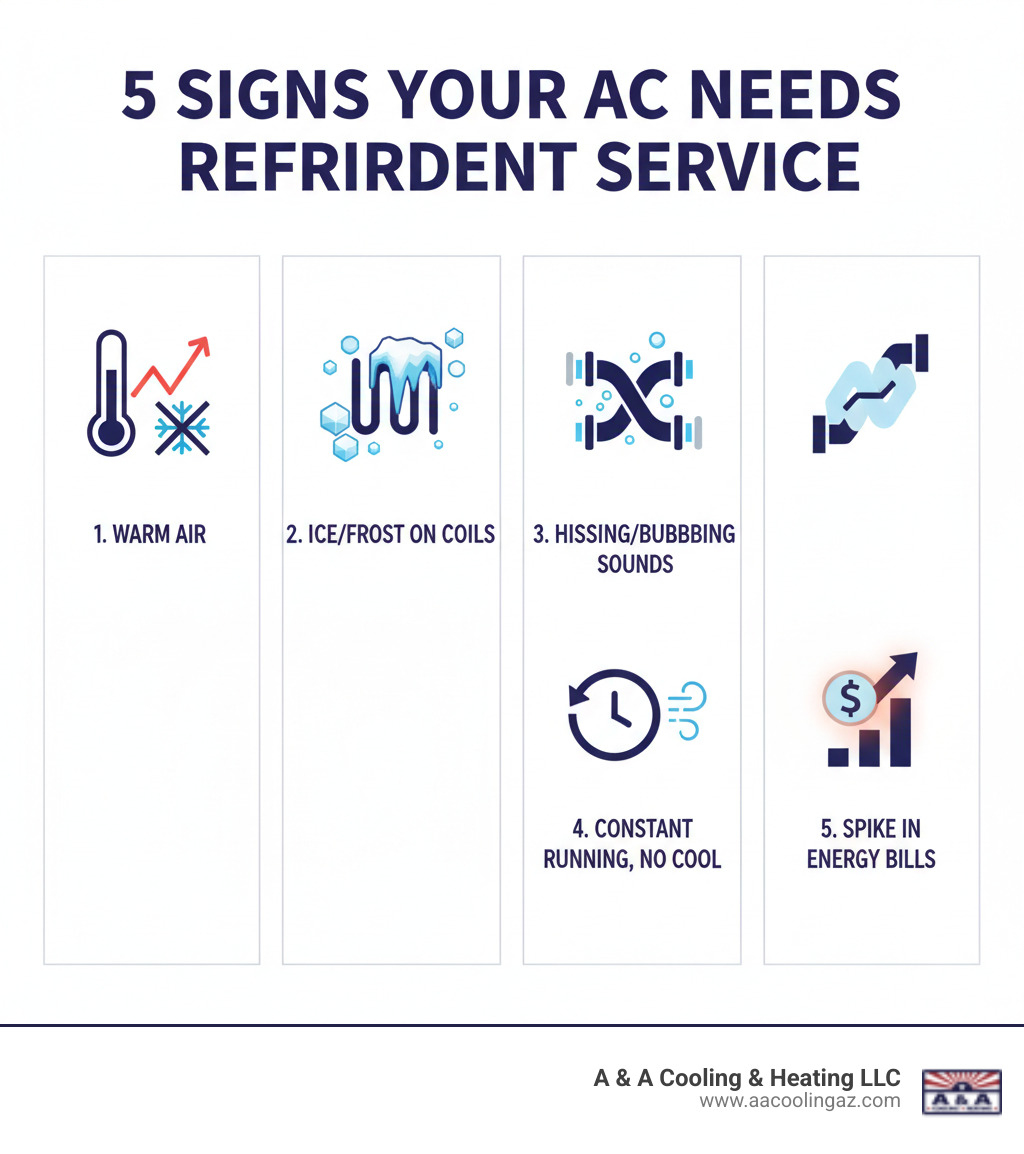
Understanding Your Home AC: When to Call a Professional
When your home AC starts acting up, many homeowners wonder if they just need a quick refrigerant top-off. However, the reality is more nuanced.

The warning signs that your AC needs professional attention are usually obvious. Blowing warm or lukewarm air is the most common red flag. Another telltale sign is ice or frost buildup on your indoor coils or outdoor refrigerant lines. You might also hear hissing or bubbling sounds near the unit, which often indicates refrigerant escaping through a leak.
Beyond these symptoms, watch for performance issues. If your AC runs constantly without cooling your home effectively, it's a problem. You'll likely notice higher energy bills as your system works overtime. Some units also start short-cycling, turning on and off repeatedly without completing a full cooling cycle.
Any of these signs means it's time to call a professional. Ignoring them will only make things worse.
Why Home AC Systems Don't Need Routine Recharges
Your home AC unit should never need routine refrigerant recharges. It operates as a sealed system, where the refrigerant is continuously reused, not consumed. Under normal circumstances, the refrigerant should last the entire lifespan of the unit.
If your system is low on refrigerant, it's not normal wear and tear. A need for a recharge always means there's a leak. This is why proper AC refrigerant recharge service always includes leak detection and repair. Just adding more refrigerant without fixing the leak is a temporary fix at best; the refrigerant will simply escape again, and your AC will continue to underperform. Finding and fixing the leak is the only real solution.
Can I Perform a Home AC Refrigerant Recharge Myself?
Recharging your home AC is one job you absolutely cannot do yourself—it's the law. Under EPA regulations, only technicians with EPA Section 608 certification can legally handle refrigerants in home AC systems.
These regulations exist for good reasons. First, refrigerants are dangerous chemicals stored under high pressure that can cause serious injuries like chemical burns or frostbite if mishandled. Second, refrigerants are potent greenhouse gases. Releasing them into the atmosphere contributes to global warming, which is why proper recovery procedures are critical.
Finally, an AC refrigerant recharge is complex. It requires specialized tools to locate leaks, measure the exact type and amount of refrigerant needed, and ensure the system operates safely. Attempting a DIY recharge could damage your HVAC equipment, lead to legal penalties, and harm you or your family. For home AC refrigerant service, calling a professional is the only legal and safe option.
The Car AC System: A DIY-Friendly Alternative?
Unlike home AC units, car AC systems can sometimes be recharged by handy owners. The signs your car needs attention are straightforward: weaker airflow, air that isn't cold, or a compressor clutch that won't engage. If the clutch isn't spinning, your refrigerant pressure is likely too low.
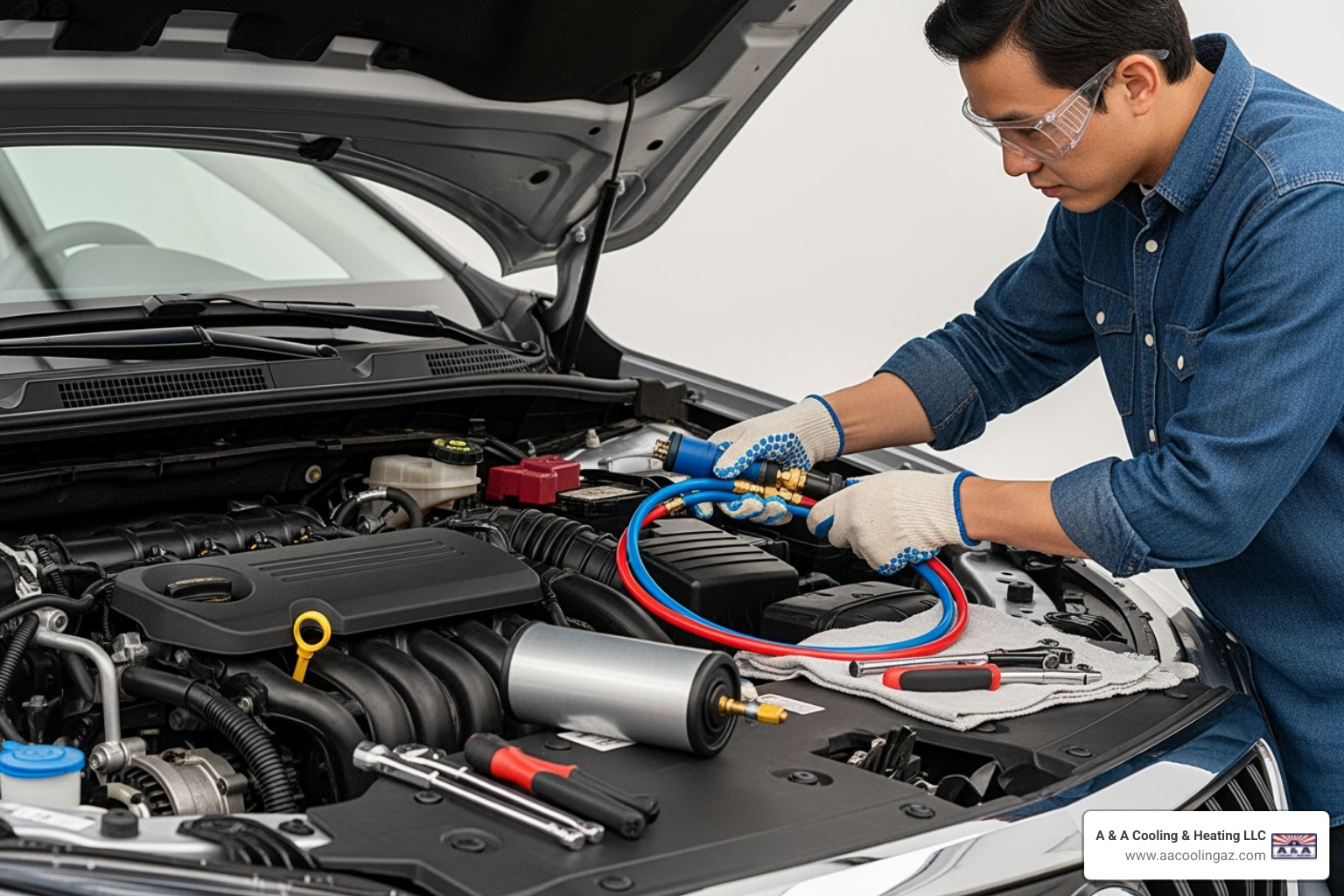
The difference is design. Car AC systems have accessible low-side service ports for adding refrigerant. While technically sealed, it's normal for small amounts of refrigerant to escape over time. Newer cars lose about 0.41 ounces per year on average, which can affect cooling performance after several years. This gradual loss is why DIY recharge kits exist for cars.
The DIY Car AC Refrigerant Recharge: A Step-by-Step Guide
If your car is blowing warm air, a DIY AC refrigerant recharge can be a good option, especially for vehicles using R-134a refrigerant (most made after 1993). Always read your car's manual and the kit's instructions first.
1. Get Ready: Wear safety glasses and gloves, as refrigerant can cause frostbite. You'll need an R-134a recharge kit with a pressure gauge. Start your car, turn the AC to max cold with the fan on high, and set it to recirculate. The outside temperature should be at least 55°F to get an accurate reading.
2. Find the Right Port: Open the hood and find the low-side service port, usually on the thicker aluminum AC line. It often has a blue or black cap marked with an "L." Your owner's manual can show you the exact location. Never use the high-side port; it's dangerous.
3. Connect and Check: Attach the kit's fitting to the low-side port. With the engine running and AC on, check the gauge. If it reads zero, you have a significant leak that needs professional repair. If the compressor clutch isn't spinning, add about half a can of refrigerant to see if it engages. If not, call a professional.
4. Add Refrigerant Carefully: Hold the can upright and squeeze the trigger to add refrigerant, watching the gauge closely. You're aiming for the green zone, typically 25 to 30 PSI, but follow your kit's instructions. Do not overcharge. Too much refrigerant reduces cooling and can damage your compressor.
5. Finish Up: Once at the correct pressure, disconnect the hose and replace the port cap securely. Store any leftover refrigerant in a cool, dry place.
If your car needs recharging every few months, you have a leak that needs professional repair. A DIY recharge is a temporary fix for a very slow leak, not a permanent solution.
Car Refrigerants and Special Considerations
Using the wrong refrigerant can damage your system. R-12 (Freon) was used in cars before 1994 and is no longer available. R-134a was the standard from 1994 through about 2013 and is what most DIY kits contain. R-1234yf is the newest refrigerant in many vehicles from 2013 onward; it requires special equipment and is not compatible with R-134a kits. Check the label under your hood to find your car's refrigerant type.
Your system also needs refrigerant oil to lubricate the compressor. Many DIY kits include oil, which is fine for a top-off. However, if the system has been opened for repairs, a professional should add the correct type and amount of oil to prevent compressor damage.
A Word of Caution for Hybrid and Electric Vehicle Owners: Do not use DIY kits on hybrid or electric vehicles. They use electric compressors that require special non-conductive oils. The standard oils in recharge kits can damage these compressors and create a serious electrical shock hazard. An AC refrigerant recharge for these vehicles should always be handled by professionals with the right equipment and knowledge.
Repair or Replace? Making the Right Long-Term Decision
When your home AC has a refrigerant leak, you face a decision: repair the leak and recharge the system, or invest in a new unit? We've helped countless Apache Junction homeowners with this question.
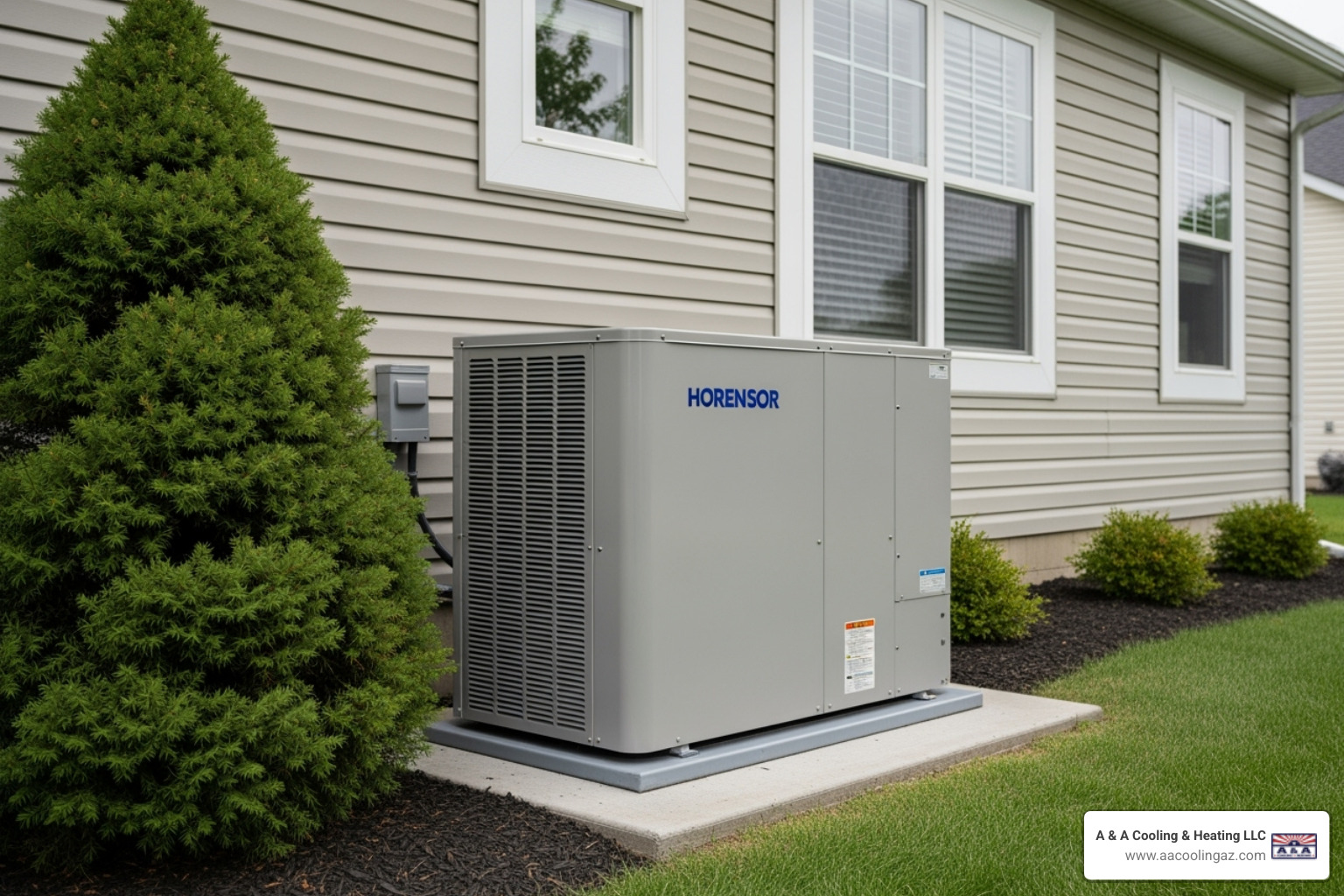
Start with your unit's age. Most AC systems last 15 to 20 years. If your unit is over 15 years old and needs a major repair, replacement often makes more financial sense. This is especially true for older systems using R-22 refrigerant (Freon), which was phased out due to environmental concerns. R-22 is now expensive and hard to find, making an AC refrigerant recharge a costly, short-term fix.
Also, consider how often your AC needs repairs. Frequent breakdowns suggest multiple components are failing, and you might be better off replacing the unit rather than continuing with patches.
Even with a perfect repair, an older unit is less efficient. Today's AC systems have much higher SEER ratings (Seasonal Energy Efficiency Ratio). Upgrading from an old unit with a SEER of 8 or 10 to a new one with a rating of 14 or higher can lead to significant energy savings on your monthly bills.
Finally, compare the repair's scope to the value of a new system. If a major component like an evaporator coil needs fixing, the repair can be substantial. In such cases, replacement is often the smarter long-term investment. You get a more efficient system with a full warranty and peace of mind.
We've served Apache Junction since 1976 and promise honest advice. Sometimes a repair is the right choice, but when it's time to replace, we'll tell you that too.
How to Extend the Lifespan of Your AC Unit
Proper care makes all the difference for your AC's longevity. The single most important step is regular professional maintenance. We recommend a tune-up each spring to clean coils, check connections, inspect for leaks, and catch small problems early. Our Cool Club maintenance plan simplifies this with scheduled service and priority attention.
Between visits, you can help by changing your air filter every one to three months. A dirty filter strains your system and increases energy use. Also, keep your outdoor condenser unit clear of debris, with at least two feet of clear space around it. Gently rinse the fins with a garden hose once or twice a season.
Inside, ensure vents aren't blocked by furniture or rugs. Proper airflow is crucial for efficiency. Consider having your ductwork inspected for leaks, as escaping cool air wastes energy. Finally, seal air leaks around windows and doors to keep hot air out and cool air in. These simple steps extend your AC's lifespan and improve its efficiency.
Frequently Asked Questions about AC Refrigerant
We've covered a lot of ground about AC refrigerant recharge services, but we know you might still have some lingering questions. Let's tackle the most common ones we hear from our Apache Junction neighbors.
How often does an AC system need to be recharged?
Here's where the difference between home and car AC systems really matters. For your home AC system, the answer might surprise you: it should never need a recharge during its entire lifespan if everything is working properly. Your home unit operates on a completely sealed system, cycling the same refrigerant continuously for years. If a technician tells you it needs more refrigerant, that's not routine maintenance—it's a clear sign of a leak that needs repair.
Now, car AC systems tell a different story. While they're also sealed, the constant vibrations, temperature swings, and movement your car experiences can cause very slow refrigerant loss over time. It's not uncommon for a car to develop tiny leaks through aging seals and connections. You might find yourself needing a recharge every few years with a minor leak. But here's the key: if you're adding refrigerant more than once every year or two, you've got a significant leak that needs professional attention, not just another temporary top-off.
How long does a car AC recharge last?
The honest answer? It depends entirely on whether you have a leak and how bad it is. Think of it like patching a tire with a slow leak versus one with a nail in it. If your car has a very minor leak—maybe from seals that have seen better days—a DIY AC refrigerant recharge might keep you comfortable for a full season or even two. You'll notice the cooling gradually becoming less effective as the refrigerant slowly escapes.
However, if you're back at the auto parts store buying another recharge kit before the next summer rolls around, or worse, within just a few months, that's your car telling you it has a real problem. At that point, repeatedly adding refrigerant is like pouring money down the drain. The leak needs to be found and fixed by a professional who has the proper equipment to locate it and repair it correctly. Plus, constantly releasing refrigerant into the atmosphere isn't doing our environment any favors either.
What are the environmental impacts of refrigerant?
This is something we take seriously, and it's a big reason why refrigerant handling is so heavily regulated. Refrigerants aren't just chemicals that make your AC cold—they're incredibly potent greenhouse gases. When they leak into the atmosphere, they contribute significantly to global warming. To put it in perspective, some refrigerants have a warming effect hundreds or even thousands of times stronger than carbon dioxide, pound for pound.
Older refrigerants like R-12 also damaged the ozone layer, which is why they were phased out. Even the more modern R-134a used in many cars still has a substantial environmental impact when released. That's precisely why the EPA requires certified technicians to handle home AC refrigerants and why they've established strict guidelines for proper recovery and disposal. You can learn more about these important guidelines at EPA.gov.
When you work with professional technicians, they're trained to recover any existing refrigerant before opening a system for repairs, preventing it from escaping into the air. They also know how to properly dispose of old or contaminated refrigerant. It's not just about following the law—it's about being responsible stewards of our environment. Every time we prevent refrigerant from leaking or ensure it's handled correctly, we're doing our small part to protect the planet for future generations.
Keep Your Cool with Expert HVAC Service
When your home's AC system starts acting up—whether it's blowing warm air, developing ice on the coils, or just not keeping up with the Arizona heat—it's telling you something important. These aren't just minor annoyances; they're signs that your system needs professional attention. And here's what we want you to remember: if your home AC needs an AC refrigerant recharge, there's always a leak somewhere that needs to be found and fixed. Simply adding more refrigerant without repairing the leak is like putting a band-aid on a broken pipe—it won't solve the problem, and you'll be right back where you started.
We've seen too many homeowners try to save money with quick fixes, only to end up spending more in the long run. That's why we always emphasize professional diagnosis for home AC units. Our certified technicians have the training, tools, and experience to pinpoint exactly what's wrong, whether it's a refrigerant leak, a failing component, or something else entirely. We'll explain what we find in plain language, discuss your options, and help you make the best decision for your home and budget.
Regular maintenance truly is your best defense against major problems. Think of it this way: you wouldn't skip oil changes for your car and expect it to run perfectly, right? Your AC system deserves the same care. Our Cool Club maintenance plan is designed to keep your system running efficiently year-round, catching those small issues before they turn into expensive emergencies. We check refrigerant levels, clean coils, inspect electrical connections, and ensure everything is working as it should—all so you can enjoy consistent comfort without worry.
Since 1976, A & A Cooling & Heating LLC has been helping Apache Junction families stay comfortable through every season. We're not just technicians who show up to fix things; we're your neighbors who genuinely care about your comfort and peace of mind. Our comprehensive heating, cooling, and air quality solutions are custom to your specific needs, and we back our work with the expertise that comes from nearly five decades of service.
Don't let a refrigerant issue or any other AC problem leave you sweating through another Arizona summer. Whether you need emergency repairs, routine maintenance, or expert advice on whether to repair or replace your system, we're here to help. Schedule your Apache Junction air conditioning & heating service today and experience the difference that trusted, professional HVAC service makes. Let us help you keep your cool!






